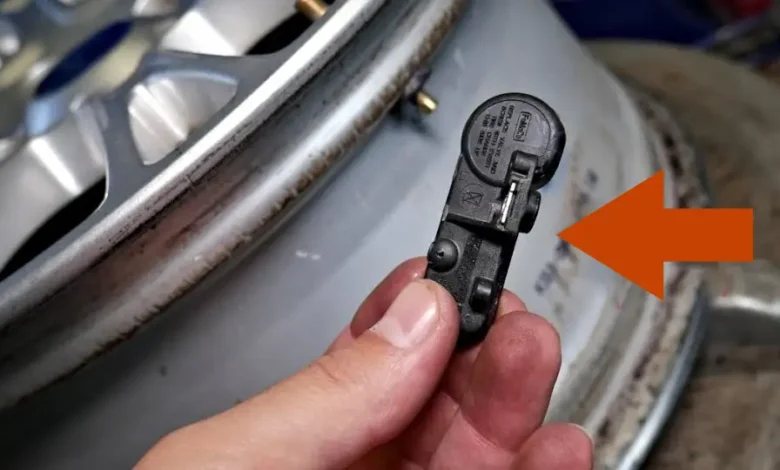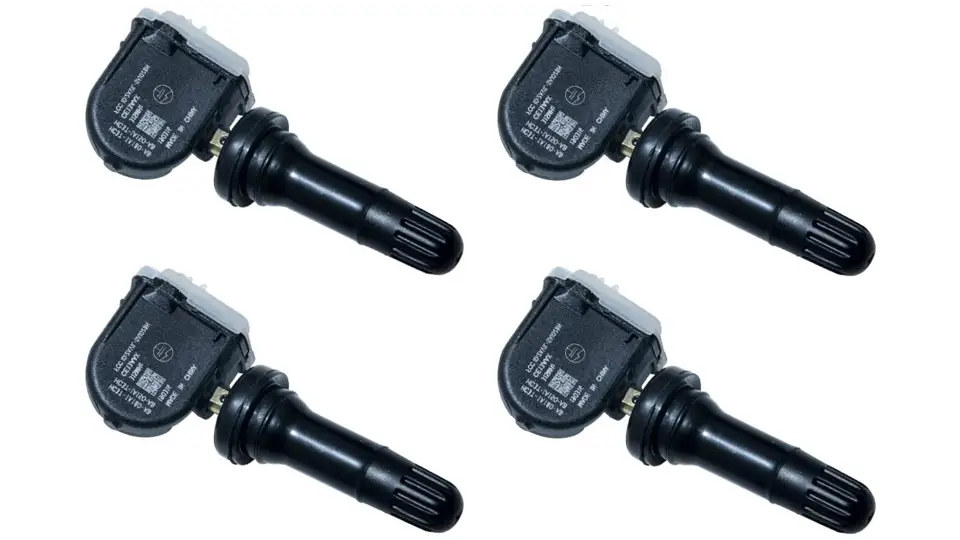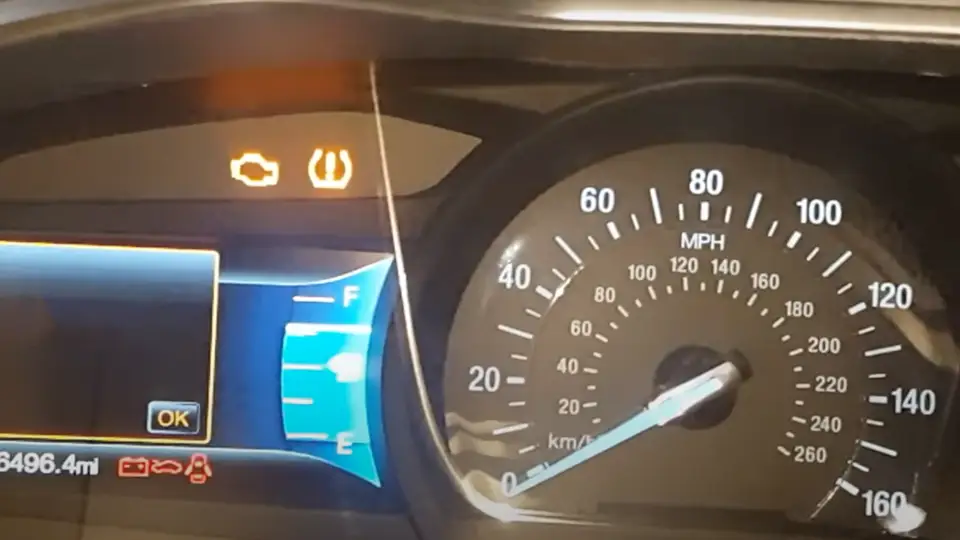
Understanding Ford Fusion TPMS Issues is essential for maintaining your vehicle’s safety, efficiency, and tire health. The Tire Pressure Monitoring System (TPMS) monitors tire pressure and alerts you to under-inflation, helping prevent accidents and ensure optimal performance. Since 2007, all vehicles in the U.S., including the Ford Fusion, feature TPMS as mandated by federal regulations. Addressing sensor faults promptly ensures better handling, fuel efficiency, and prolonged tire life.
Addressing tire pressure sensor faults is vital for ensuring vehicle safety and optimal performance. Under-inflated tires can lead to reduced fuel efficiency, poor handling, and even dangerous tire blowouts. By quickly responding to TPMS alerts, drivers can avoid these risks, prolong tire life, and improve their overall driving experience.
By understanding how TPMS works and knowing how to fix common faults, you’ll stay ahead of potential issues and keep your Ford Fusion in top condition.
What is a Tire Pressure Sensor?
A Tire Pressure Monitoring System (TPMS) is a safety feature designed to monitor the air pressure inside your tires in real time. Each tire has a small sensor that measures the internal pressure and transmits the data to the vehicle’s onboard computer. If the air pressure drops below the manufacturer’s recommended level, the system triggers a warning light on the dashboard, alerting the driver.
There are two main types of TPMS:
- Direct TPMS: Sensors are installed inside each tire, measuring the actual tire pressure and sending the data directly to the vehicle’s computer.
- Indirect TPMS: This system relies on the car’s ABS (Anti-lock Braking System) to detect differences in wheel speed, which can indicate changes in tire pressure.
Maintaining proper tire pressure is crucial for several reasons:
- Safety: Under-inflated tires can compromise your vehicle’s handling and increase the risk of accidents, especially at high speeds or during emergency maneuvers.
- Fuel Efficiency: Properly inflated tires reduce rolling resistance, which improves fuel efficiency and saves money on gas.
- Tire Lifespan: Tires that are consistently under-inflated wear unevenly, reducing their lifespan and increasing the likelihood of blowouts or other failures.
By regularly checking and maintaining tire pressure, you can avoid unnecessary risks and maximize the performance and longevity of your tires.
Common Causes of Ford Fusion Tire Pressure Sensor Fault
Low Tire Pressure
Low tire pressure is one of the most common causes of a TPMS warning light in the Ford Fusion. When the air pressure inside one or more tires drops below the manufacturer’s recommended level, the tire pressure sensor detects this and triggers the warning. Under-inflated tires can be caused by temperature fluctuations, slow leaks, or punctures.
How to Check and Maintain Proper Tire Pressure:
- Use a tire pressure gauge to measure each tire’s pressure when the tires are cold.
- Compare the reading to the manufacturer’s recommended tire pressure, which can typically be found on the driver’s side door jamb or in the owner’s manual.
- If necessary, add air using a pump or visit a service station with an air compressor.
- Check tire pressure monthly and before long trips to ensure optimal performance.
New Wheel or Tire Replacement
When you replace the wheels or swap tires (such as changing between summer and winter tires), the TPMS system may lose its calibration. The sensors in the tires need to communicate with the vehicle’s computer, and changing tires without recalibrating the system can cause the sensor to malfunction or display incorrect data.
Why Recalibrating the Sensor is Important:
- Each tire and wheel setup may require different pressure levels. You need to retrain the TPMS to recognize the new set of tires and their specific pressure.
- If you don’t reset the system after a tire change, it may trigger false warnings or miss alerts when your tires are under-inflated.
After any tire replacement, follow the TPMS recalibration, procedure for your Ford Fusion. You can perform this manually or use an OBD2 scanner, depending on the model year.
Faulty Tire Pressure Sensor
Over time, the sensors inside your tires can wear out, leading to malfunctions. A faulty sensor may send incorrect data or no data at all, causing the TPMS warning light to stay on even when tire pressure is fine.
Signs of a Faulty Sensor:
- Persistent TPMS light despite properly inflated tires.
- Erratic or inconsistent tire pressure readings.
Typical Sensor Lifespan and Causes of Failure:
- The average lifespan of a tire pressure sensor is around 5 to 7 years, largely depending on the battery inside the sensor.
- Corrosion, particularly around the valve stem, can lead to sensor failure. Metal sensors are more prone to corrosion than rubber ones.
If your tire pressure sensor is faulty, replacing it may be necessary to ensure accurate readings.
Tire Pressure Sensor Lost Memory
Sometimes, the TPMS sensors lose their connection with the vehicle’s computer, a situation commonly referred to as the sensor “losing memory.” This can happen due to various factors like hitting a hard bump, driving on rough roads, or after changing tires without recalibrating the system.
Common Scenarios for Lost Sensor Memory:
- Hitting a hard bump or pothole can cause the sensor to temporarily disconnect.
- Tire or wheel replacement without proper recalibration can confuse the system, leading to a warning light.
To fix this issue, the sensors need to be relearned by the vehicle’s computer. This can be done manually through specific procedures or by using specialized tools such as an OBD2 scanner

How to Fix Ford Fusion Tire Pressure Sensor Fault
Step 1: Check Tire Pressure and Inflate Tires
The first step in addressing a tire pressure sensor fault is to check and adjust your tire pressure. Under-inflated tires are often the root cause of the warning light.
Guide on Using a Tire Pressure Gauge:
- Remove the valve stem cap from the tire.
- Press the tire pressure gauge onto the valve stem to get a reading.
- Compare the reading to the recommended tire pressure, typically listed on the driver’s side door or in the vehicle’s manual.
Best Practices for Inflating Tires:
- Inflate the tires when they are cold, as heat from driving can cause inaccurate readings.
- Use an air compressor to fill the tire to the recommended pressure. This can be done at a gas station or with a home air compressor.
- Avoid overinflation. If necessary, use a tire deflator to release excess air.
- After filling the tires, recheck the pressure to ensure accuracy.
Step 2: Use OBD2 Scanner to Identify Faulty Sensor
If adjusting the tire pressure doesn’t resolve the issue, the next step is to use an OBD2 scanner to identify any faulty sensors.
How to Scan for TPMS Issues Using an OBD2 Scanner:
- Plug the OBD2 scanner into the vehicle’s diagnostic port, typically located beneath the dashboard.
- Turn the ignition to the “ON” position, but don’t start the engine.
- Use the scanner to run a diagnostic scan on the TPMS system. The scanner will check for error codes related to the tire pressure sensors.
What to Do if a Faulty Sensor is Identified:
- If the scanner identifies a specific sensor that is malfunctioning, note the location (e.g., front left tire).
- Prepare to either repair or replace the faulty sensor in the next step.
Step 3: Replace or Fix Faulty Sensor
When the TPMS warning is caused by a faulty sensor, it will need to be repaired or replaced.
Steps to Remove and Replace a Faulty Sensor:
- Jack up the car and remove the wheel associated with the faulty sensor.
- Deflate the tire and remove it from the wheel.
- Locate the TPMS sensor attached to the valve stem. Unscrew and remove the sensor.
- Install the new TPMS sensor in the same position, securing it to the valve stem.
- Reinstall the tire, inflate it, and mount the wheel back onto the car.
When to Seek Professional Help:
- If you’re uncomfortable with removing the tire or lack the necessary tools, visit a professional mechanic or tire shop. They can replace the sensor for you, often quickly and affordably.
Step 4: Reset Tire Pressure Monitoring System
After replacing or adjusting the sensors, you will need to reset the TPMS to ensure the system recognizes the changes.
Manual Reset Instructions (Standard Ignition):
- Inflate all tires to the recommended pressure.
- Turn the ignition to the “OFF” position.
- Step on and off the brake pedal.
- Turn the ignition to “ON” and “OFF” rapidly without starting the engine.
- Repeat these steps, listening for a horn chirp, which indicates the system has entered reset mode.
- Use a TPMS tool to activate the sensors, following the steps displayed on the dashboard.
- Complete the process for all four tires, and the system should reset.
Resetting TPMS with OBD2 Tools:
- After replacing or recalibrating the sensors, connect the OBD2 scanner and use it to send new data to the vehicle’s computer.
- Inflate all tires to the correct pressure.
- Activate the sensors using the TPMS tool, following the prompts on the scanner.
Importance of Driving for Sensor Recalibration:
- After resetting the TPMS, it is essential to drive the vehicle for at least five minutes at speeds over 28 mph. This allows the sensors to recalibrate and transmit accurate data to the vehicle’s computer, completing the reset process.

Frequently Asked Questions
- Is it Safe to Drive with a Tire Pressure Sensor Fault?
Yes, but it’s not advisable for long-term driving. While you can continue driving as long as you regularly check and maintain the correct tire pressure manually, a malfunctioning sensor increases the risk of driving on under-inflated tires, which can lead to accidents, poor fuel efficiency, and uneven tire wear.
- How Much Does it Cost to Replace a Tire Pressure Sensor?
The cost of replacing a tire pressure sensor typically ranges from $30 to $80 per sensor, depending on the make and model of the sensor. If you choose professional installation, you may need to pay an additional $30 to $50 for labor.
- How Often Should You Check Tire Pressure Manually?
It is recommended to manually check your tire pressure at least once a month and before long trips. This ensures optimal tire performance, safety, and fuel efficiency.
- What Causes Tire Pressure Sensors to Fail?
Tire pressure sensors typically fail due to battery depletion (which can last 5 to 7 years), corrosion around the valve stem, or physical damage from rough roads or improper tire handling.
- Can You Recalibrate Tire Pressure Sensors After a Tire Change?
Yes, you need to recalibrate or reset tire pressure sensors after changing tires, especially when switching between seasonal tires or replacing wheels. This ensures the TPMS system accurately reads the new tire pressures.
- What Happens if I Don’t Reset the TPMS After Changing Tires?
If you don’t reset the TPMS after changing tires, the system may display incorrect tire pressure readings or fail to warn you about under-inflation. This could lead to driving on unsafe tires without realizing it.
- How Long Do Tire Pressure Sensors Typically Last?
Tire pressure sensors generally last between 5 to 7 years, depending on usage, weather conditions, and sensor quality. The primary reason for failure is battery depletion.
- What Does the TPMS Warning Light Mean?
The TPMS warning light means that one or more tires may be under-inflated, or there is a fault in the tire pressure monitoring system. It’s important to check your tire pressure immediately when this light comes on.
- Can I Use Aftermarket Sensors on My Ford Fusion?
Yes, you can use aftermarket tire pressure sensors for your Ford Fusion, but make sure they are compatible with the vehicle’s TPMS system. Some may require special programming or calibration.
- How Does Temperature Affect Tire Pressure?
Tire pressure decreases in cold weather and increases in hot weather due to the expansion and contraction of air. It’s common to lose about 1-2 PSI for every 10°F drop in temperature.
- Can a Tire Pressure Sensor Be Fixed, or Does It Need Replacement?
In most cases, if a sensor is malfunctioning due to battery failure or physical damage, it will need to be replaced rather than repaired. However, if the sensor lost connection, a reset might fix the issue.
- Will the TPMS Warning Light Turn Off Automatically After Fixing the Issue?
In most cases, the TPMS light will turn off automatically after inflating the tires to the correct pressure or replacing faulty sensors. However, if it remains on, a manual reset may be required.
- Can I Replace a Tire Pressure Sensor Myself?
Yes, it is possible to replace a tire pressure sensor yourself if you have the right tools, including a jack, tire tools, and a TPMS tool. However, professional installation may be easier for those without experience.
- Do I Need a Special Tool to Reset the TPMS?
Yes, some TPMS resets require a TPMS tool or OBD2 scanner, especially in vehicles with complex systems. For others, a manual reset using the ignition and brake pedal might be sufficient.
- What Should I Do If My Tire Pressure Sensor Warning Light Flashes?
A flashing TPMS light often indicates a malfunction in the system, not just low tire pressure. This could be due to a faulty sensor or a loss of communication with the vehicle’s computer. You should scan the system with an OBD2 scanner to identify the issue.
Conclusion
In summary, several common causes can trigger tire pressure sensor faults in Ford Fusion vehicles, including low tire pressure, new wheel or tire replacements, faulty tire pressure sensors, and lost sensor memory. Fortunately, you can address each of these issues by following a few straightforward steps, such as checking and inflating your tires, using an OBD2 scanner to diagnose sensor faults, replacing faulty sensors, and resetting the TPMS system.
Regular tire maintenance plays a critical role in avoiding TPMS issues. By properly inflating your tires—especially during seasonal temperature changes or after tire replacements—you can prevent unnecessary wear, improve fuel efficiency, and maintain safe driving conditions.
To ensure optimal tire health and vehicle safety, check your tire pressure monthly, replace sensors when needed, and recalibrate your TPMS after any tire changes. When you stay proactive with tire care, you not only prevent TPMS faults but also enjoy a smoother, safer driving experience.




